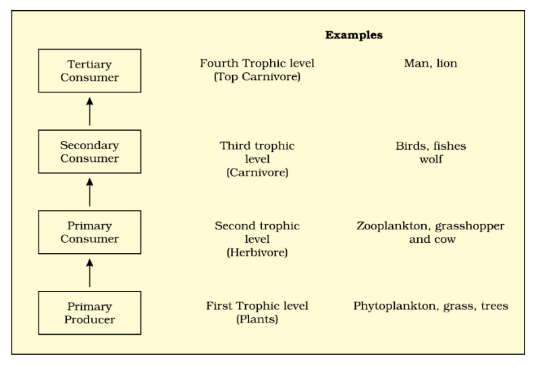Food Chain and Food Web
Energy Flow
Except for the deep sea hydro-thermal ecosystem, sun is the only source of energy for all ecosystems on Earth. Of the incident solar radiation less than 50 per cent of it is photosynthetically active radiation (PAR). Plants and photosynthetic bacteria (autotrophs), fix Sun’s radiant energy to make food from simple inorganic materials. Plants capture only 2-10 per cent of the PAR and this small amount of energy sustains the entire living world. All organisms are dependent for their food on producers, either directly or indirectly. So you find unidirectional flow of energy from the sun to producers and then to consumers. Further, ecosystems need a constant supply of energy to synthesise the molecules they require, to counteract the universal tendency toward increasing disorderliness.
Food Chain and Food Web
- The green plants in the ecosystem are called producers. Starting from the plants (or producers) food chains or rather webs are formed such that an animal feeds on a plant or on another animal and in turn is food for another. The chain or web is formed because of this interdependency. No energy that is trapped into an organism remains in it for ever. The energy trapped by the producer, hence, is either passed on to a consumer or the organism dies. Death of organism is the beginning of the detritus food chain/web. All animals depend on plants (directly or indirectly) for their food needs. They are hence called consumers and also heterotrophs. If they feed on the producers, the plants, they are called primary consumers, and if the animals eat other animals which in turn eat the plants (or their produce) they are called secondary consumers. Likewise, you could have tertiary consumers too.
- The primary consumers will be herbivores. Some common herbivores are insects, birds and mammals in terrestrial ecosystem and molluscs in aquatic ecosystem. The consumers that feed on these herbivores are carnivores, or more correctly primary carnivores (though secondary consumers). Those animals that depend on the primary carnivores for food are labelled secondary carnivores. A simple grazing food chain (GFC) is depicted below:

- The detritus food chain (DFC) begins with dead organic matter. It is made up of decomposers which are heterotrophic
organisms, mainly fungi and bacteria. They meet their energy and nutrient requirements by degrading dead organic matter
or detritus. These are also known as saprotrophs (sapro: to decompose). Decomposers secrete digestive enzymes
that breakdown dead and waste materials into simple, inorganic materials, which are subsequently absorbed by them. - In an aquatic ecosystem, GFC is the major conduit for energy flow. As against this, in a terrestrial ecosystem, a much
larger fraction of energy flows through the detritus food chain than through the GFC. Detritus food chain may be
connected with the grazing food chain at some levels: some of the organisms of DFC are prey to the GFC animals, and
in a natural ecosystem, some animals like cockroaches, crows, etc., are omnivores. These natural interconnection of food
chains make it a food web.
Trophic Level
- Organisms occupy a place in the natural surroundings or in a community according to their feeding relationship with other organisms. Based on the source of their nutrition or food, organisms occupy a specific place in the food chain that is known as their trophic level. Producers belong to the first trophic level, herbivores (primary consumer) to the second and carnivores (secondary consumer) to the third.
- The amount of energy decreases at successive trophic levels. When any organism dies it is converted to detritus or dead biomass that serves as an energy source for decomposers. Organisms at each trophic level depend on those at the lower trophic level for their energy demands. Each trophic level has a certain mass of living material at a particular time called as the standing crop. The standing crop is measured as the mass of living organisms (biomass) or the number in a unit area. The biomass of a species is expressed in terms of fresh or dry weight. Measurement of biomass in terms of dry weight is more accurate.

Significance of Studying Food Chains
- It helps in understanding the feeding relations and interactions among different organisms of an ecosystem.
- It explains the flow of energy and circulation of materials in ecosystems.
- It helps in understanding the concept of biomagnification in ecosystems.
Ecological Efficiency
- It is clear from the trophic structure of an ecosystem that the amount of energy decreases at each subsequent trophic level. This is due to two reasons:
• At each trophic a part of the available energy is lost in respiration or used up in metabolism.
• A part of energy is lost at each transformation, i.e. when it moves from lower to higer trophic level as heat. - The ratio between the amount of energy acquired from the lower trophic level and the amount of energy transferred from higher trophic level is called ecological efficiency. Lindman in 1942 defined these ecological efficiencies for the 1st time and proposed 10% rule e.g. if autotrophs produce 100 cal, herbivores will be able to store 10 cal. and carnivores 1cal. However, there may be slight variations in different ecosystems and ecological efficiencies may range from 5 to 35%.
Bioaccumulation and Biomagnification
- Bioaccumulation refers to how pollutants enter a food chain. In bioaccumulation there is an increase in concentration of a pollutant from the environment to the first organism in a food chain.
- Biomagnification refers to the tendency of pollutants to concentrate as they move from one trophic level to the next. Thus in biomagnification there is an increase in concentration of a pollutant from one link in a food chain to another. In order for biomagnification to occur, the pollutant must be long-lived; mobile; soluble in fats; and biologically active.


